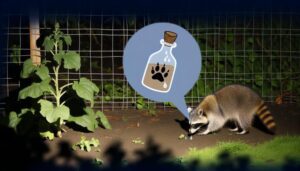How Do Raccoons Keep Snakes Away Naturally?
Raccoons exhibit predatory behavior towards snakes, which can influence snake populations in shared habitats. As omnivores with a flexible diet, raccoons have been documented consuming snakes when available.
This dietary preference, combined with raccoons' territorial behavior, suggests they might serve as a natural deterrent in some contexts. However, raccoons can also introduce other ecological risks, complicating their role in pest management.
While raccoons might aid in reducing snake encounters, a detailed approach involving multiple strategies is generally more effective for sustainable wildlife management. To explore the nuanced relationship between raccoons and snakes, consider further insights into integrated pest control techniques.

Key Takeaways
- Raccoons are known to eat snakes, which could potentially reduce snake populations in certain areas.
- As territorial animals, raccoons may deter snakes through their presence and activity in shared habitats.
- Raccoons' nocturnal behavior aligns with the active periods of many snake species, increasing their likelihood of encounters.
- The presence of raccoons alone is not a guaranteed method for keeping all snakes away.
- An integrated pest management approach, including physical barriers and landscaping, is more effective for snake deterrence.
Raccoon Diet and Habits
Raccoons (Procyon lotor) display omnivorous feeding behavior, consuming a diverse range of food items including fruits, insects, small mammals, and aquatic organisms. Their dietary flexibility allows them to thrive in various environments, from forests to urban areas.
Raccoons are primarily nocturnal, using their dexterous forepaws to forage for food efficiently. Evidence suggests that their opportunistic feeding habits may influence local ecosystems by controlling prey populations.
Additionally, raccoons exhibit complex social structures and territorial behaviors, often denning in tree cavities or abandoned buildings. Understanding raccoon diet and habits is essential for wildlife management and conservation efforts, as these factors greatly impact their interactions with other species and their role in ecosystem dynamics.
Snake Behavior Overview
Snake behavior is characterized by a diverse range of activities and adaptations that enable these reptiles to thrive in various habitats. These behaviors are essential for their survival, predation, and reproduction. Snakes exhibit remarkable behavioral plasticity, which allows them to adjust to different environmental conditions.
Key behaviors include:
- Thermoregulation: Snakes regulate their body temperature through basking and seeking shade.
- Camouflage: Many snakes use coloration and patterns to blend into their surroundings, avoiding detection by both prey and predators.
- Locomotion: Snakes employ various modes of movement such as slithering, sidewinding, and concertina motion.
- Hunting Strategies: They utilize ambush tactics, active foraging, and constriction or envenomation to subdue prey.
These behaviors illustrate the complexity and adaptability of snake species across ecosystems.
Predatory Tendencies of Raccoons
With their omnivorous diet and opportunistic feeding habits, raccoons exhibit a range of predatory behaviors that impact various species within their ecological niches.
Raccoons (Procyon lotor) are known to consume a variety of prey, including small mammals, birds, amphibians, and invertebrates. Their agile forepaws and acute sense of touch enable them to capture and manipulate prey effectively.
Studies have documented raccoons predating on nests, thereby affecting bird populations and other small fauna. Additionally, their foraging behavior can lead to significant disruptions in local ecosystems.
Their predatory tendencies are driven by food availability and habitat conditions, underscoring their role as adaptable, yet potentially disruptive, predators within their environments.
Do Raccoons Eat Snakes?
Raccoons are opportunistic feeders, employing a variety of hunting techniques to capture prey, including snakes. Consuming snakes provides raccoons with essential nutrients such as proteins and fats, contributing to their dietary requirements.
Evidence indicates that while snakes are not a primary food source, they are consumed when available, highlighting the raccoon's adaptability in its feeding habits.
Raccoons' Hunting Techniques
Raccoons, known for their opportunistic feeding behavior, employ various hunting techniques that can include preying on snakes. These techniques are characterized by adaptability and resourcefulness, allowing raccoons to exploit a wide range of food sources.
Key aspects of their hunting strategies include:
- Nocturnal Hunting: Raccoons are primarily active at night, which aids in ambushing unsuspecting prey, including snakes.
- Dexterous Paws: The manual dexterity of raccoons allows them to grasp and manipulate snakes effectively.
- Acute Senses: Enhanced olfactory and auditory senses enable raccoons to detect and locate snakes hidden within their environment.
- Opportunistic Diet: Their non-specific diet makes them adaptable predators, ready to include snakes when available.
These techniques underscore the raccoon's ability to thrive in diverse habitats.
Snake Nutritional Value
Given their opportunistic hunting techniques, it is essential to examine whether snakes constitute a significant part of a raccoon's diet and their nutritional value.
Scientific observations indicate that raccoons do consume snakes when available, although they do not primarily rely on them. Snakes provide a substantial source of protein and essential amino acids, which are pivotal for the growth and maintenance of raccoons' muscular and skeletal systems. Additionally, fats present in snakes contribute to the energy reserves necessary for raccoons' nocturnal activities.
However, the frequency of snake consumption varies based on habitat and snake availability. Overall, while snakes can be a beneficial dietary supplement, raccoons exhibit dietary flexibility, incorporating a wide array of other food sources to meet their nutritional needs.
Habitat Overlap
Raccoons and snakes often inhabit overlapping environments, including forests, wetlands, and urban areas, due to their shared environmental preferences.
This habitat overlap can lead to territorial interactions where the presence of raccoons may influence snake behavior and distribution.
Understanding the predatory behavior dynamics between these species is essential to determine whether raccoons effectively deter snakes from specific areas.
Shared Environmental Preferences
Both raccoons and snakes exhibit overlapping habitat preferences, often favoring environments such as wooded areas, wetlands, and urban regions with ample food and shelter. This habitat overlap is due to shared ecological requirements, which include:
- Abundant food sources: Both species are opportunistic feeders, relying on varied diets available in these habitats.
- Shelter availability: Dense foliage and structures provide essential refuge from predators and harsh weather.
- Water proximity: Access to water bodies supports hydration needs and hunting opportunities.
- Temperature regulation: Environments offering microhabitats assist in thermoregulation vital for both ectothermic snakes and endothermic raccoons.
Understanding these shared environmental preferences helps in comprehending the dynamics of raccoon and snake populations cohabiting within the same ecological niches, setting the stage for exploring their interactions.
Territorial Interactions
The territorial interactions between raccoons and snakes, influenced by their overlapping habitats, reveal complex dynamics driven by competition for resources and space. Raccoons (Procyon lotor) and various snake species often inhabit similar environments such as forests, wetlands, and urban areas.
Studies indicate that raccoons are highly adaptable omnivores, often foraging in areas frequented by snakes for food sources such as small mammals, insects, and eggs. This overlapping habitat can lead to encounters where raccoons may disrupt snake activities, primarily through physical presence and scent marking.
Although direct confrontations are not extensively documented, the presence of raccoons has been observed to cause snakes to relocate to less disturbed areas, indirectly influencing snake population distributions within shared territories.
Predatory Behavior Dynamics
In habitats where raccoons and snakes coexist, predatory behavior dynamics are shaped by the availability of prey and the inherent predation risks each species faces. Raccoons, being opportunistic feeders, may prey on snakes, particularly smaller or juvenile ones, while snakes could pose a threat to raccoon kits.
The interaction between these species can be influenced by several factors:
- Prey abundance: High prey availability reduces direct competition.
- Habitat complexity: Dense vegetation and varied terrain offer both refuge and hunting grounds.
- Activity patterns: Nocturnal and diurnal shifts minimize encounters.
- Predation risk: Both species must navigate predation threats from larger predators.
Understanding these dynamics helps in managing ecosystems where raccoons and snakes are present, ensuring a balanced and sustainable environment.
Natural Deterrents
Although raccoons are known to prey on snakes, their presence alone is not a reliable natural deterrent for snake populations. Ecological studies indicate that while raccoons contribute to controlling snake numbers, their impact is limited by factors such as habitat diversity and prey availability.
Moreover, raccoons are opportunistic feeders with a varied diet, which reduces their effectiveness as specialized snake predators. Instead, integrated pest management strategies incorporating multiple natural deterrents, like maintaining healthy ecosystems with diverse predator species, are more effective.
For instance, promoting habitats that support birds of prey, which are consistent snake predators, can provide a more balanced approach. Therefore, relying solely on raccoons to mitigate snake presence is insufficient and requires a multifaceted ecological perspective.
Observed Interactions
Field observations reveal intricate interactions between raccoons and snakes that shed light on the dynamics of predator-prey relationships in diverse ecosystems.
These interactions are characterized by several notable behaviors:
- Predation: Raccoons have been documented preying on snakes, particularly during the snakes' vulnerable stages, such as during shedding or in nests.
- Avoidance: Snakes may avoid areas with high raccoon activity, likely due to the perceived threat.
- Territorial Influence: Raccoons, being territorial creatures, can indirectly influence snake populations by altering the habitat.
- Scavenging: Raccoons often scavenge on snake carcasses, indicating an opportunistic feeding strategy.
These interactions underscore the complex ecological balance and mutual adaptations that define raccoon-snake relationships, emphasizing the importance of understanding these dynamics for effective wildlife management.
Scientific Studies
Scientific studies have examined the predator-prey relationships between raccoons and snakes, analyzing how their interactions influence ecosystem dynamics.
Research has also investigated habitat overlap to determine whether raccoons' presence statistically correlates with reduced snake populations.
These studies provide a foundation for understanding the ecological impact of raccoons on snake behavior and distribution.
Predator-Prey Relationships
Recent studies on predator-prey relationships have revealed intricate interactions between raccoons and snakes, shedding light on the potential impact raccoons may have on snake populations. Research indicates several critical factors in understanding this dynamic:
- Diet Analysis: Raccoons are omnivores, and their diet occasionally includes small snakes and snake eggs.
- Behavioral Observations: Raccoons exhibit behaviors such as raiding nests that could reduce snake hatchling survival rates.
- Population Studies: Areas with high raccoon densities often show lower snake populations, suggesting predation pressure.
- Ecosystem Impact: Raccoon predation on snakes can indirectly affect other species and overall biodiversity.
These findings suggest that raccoons may play a significant role in modulating snake populations through direct predation and other ecological interactions.
Habitat Overlap Analysis
Analyzing habitat overlap between raccoons and snakes reveals critical insights into their spatial interactions and potential competitive dynamics. Scientific studies using radio telemetry and geographic information systems (GIS) have demonstrated significant habitat co-occurrence.
Raccoons (Procyon lotor) often occupy diverse environments, including wetlands and forests, where various snake species, such as the Eastern rat snake (Pantherophis alleghaniensis), are also prevalent. While raccoons are opportunistic omnivores, their predation on snakes is context-dependent, influenced by prey availability and environmental conditions.
Additionally, raccoons' foraging behavior can indirectly affect snake populations by altering habitat structures. Thorough habitat overlap analyses contribute to understanding how these species coexist, informing conservation strategies that serve to maintain ecological balance and protect biodiversity.
Benefits of Raccoons
Among the benefits of raccoons, their role as natural pest controllers stands out, particularly due to their predation on insects and small rodents. This ecological function contributes to maintaining balanced ecosystems and reducing the prevalence of agricultural pests. Scientific studies have indicated several benefits linked to raccoon activity:
- Insect Population Control: Raccoons consume a variety of insects, mitigating potential infestations.
- Rodent Regulation: Their predation on small rodents helps control populations that could otherwise damage crops and spread disease.
- Seed Dispersal: By consuming fruits and subsequently dispersing seeds, raccoons facilitate plant propagation.
- Ecosystem Balance: Their foraging habits help in nutrient cycling and soil aeration, promoting a healthier environment.
These benefits underscore the ecological value raccoons provide.
Potential Risks
While raccoons provide various ecological benefits, they also pose potential risks that need to be carefully considered. Among these risks are the transmission of zoonotic diseases, property damage, and competition with native species. Raccoons can carry pathogens such as rabies and leptospirosis, which pose health risks to humans and pets. Additionally, their foraging behavior often results in structural damage to homes and gardens.
| Risk Factor | Potential Impact |
|---|---|
| Disease Transmission | Rabies, Leptospirosis |
| Property Damage | Structural harm to homes and gardens |
| Ecological Competition | Displacement of native species |
These factors highlight the necessity of a balanced approach when considering raccoons as a natural deterrent for snakes, ensuring that benefits outweigh the potential hazards.
Alternative Pest Control
A variety of alternative pest control methods can be employed to manage snake populations effectively and sustainably. Scientific literature suggests that integrated approaches are more effective than relying on a single method. Some evidence-based alternatives include:
- Habitat modification: Removing debris and excess vegetation to reduce snake hiding spots.
- Biological control: Introducing natural predators like certain birds or mammals to control snake populations.
- Chemical repellents: Applying snake repellents that contain naphthalene or sulfur around the property perimeter.
- Physical barriers: Installing snake-proof fencing to prevent entry.
These methods collectively contribute to a safer environment by targeting different aspects of snake behavior and ecology. Employing a combination of these strategies can optimize pest control while minimizing environmental impact.
Practical Tips
Implementing practical tips grounded in scientific evidence can greatly enhance the effectiveness of managing snake populations around your property. To start with, maintaining a clean yard by removing debris, woodpiles, and tall grass can deter snakes, as these are common hiding spots.
Next, installing snake-proof fencing, typically made of fine mesh, can provide a physical barrier against snake entry.
Thirdly, using natural predators such as raccoons can be beneficial, although their efficacy is variable and should not be solely relied upon.
Additionally, employing commercial snake repellents, while controversial in effectiveness, can be an adjunct measure.
Conclusion
Research indicates that raccoons, known for their opportunistic feeding habits, do occasionally prey on snakes, contributing to a modest reduction in local snake populations. An interesting statistic reveals that raccoons consume snakes in approximately 15% of their diet, highlighting their role in controlling snake numbers.
However, relying solely on raccoons for snake control presents potential risks, such as the spread of raccoon-borne diseases. Consequently, integrated pest management strategies are recommended for effective and balanced ecosystem regulation.






